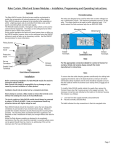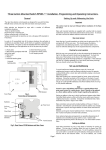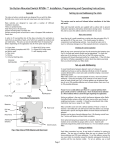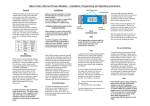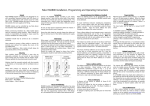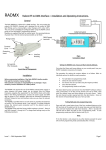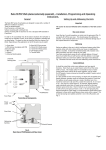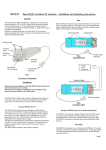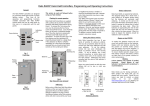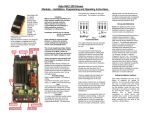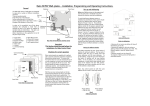Download Three button Hand Held Transmitter RAH03
Transcript
Three button Hand Held Transmitter RAH03 Installation, Programming and Operating Instructions. General Rear cover removal. The rako three button hand held controllers are designed for use with the Rako RACUB motor control units only with raise lower and stop functions. Remove the rear cover by undoing the four fixing screws (see Fig.2) and gently pulling the rear cover away. Open/Close / Stop buttons Fig. 3 Rear View with cover removed Checking for correct operation With the rear cover removed pull out the tab protecting the batteries (see Fig.3); the Rako transmitter should now be operational. To check this press one of the buttons on the front of the PCB retainer and the indicating LED should illuminate briefly for a single flash. If the LED does not flash or it flashes repeatedly for a short burst (low battery warning) then you should contact your Rako dealer. Fig. 1 Front View Set-up and Addressing To avoid interference between adjacent rooms of a house and neighbouring houses as well as allowing individual control of separate curtains/blinds within a room Rako transmitters employ a structured addressing system. Rako transmitters use a structure based on house, room and channel addresses. Using the two banks of DIL switches on the back of a wall panel or hand control (see Fig.3) a House address can be selected from one of up to 255 possible addresses and a Room address from one of up to 255 possible addresses. Fixing screws Rear cover Note House 0 is not a valid address and Room 0 is a special address which gives overall control for a whole house. Room 0 should not be selected as a Room address without careful thought regarding the application. Setting an address is the way in which interference between other Radio Controlled Rako systems, either with other rooms within your house or neighbouring houses is avoided. It should be remembered that a Rako transmitter may have a range of over 100m. Fig. 2 Rear View Rako transmitters come set with a default address of House 1, Room 4, Channel 1 and whilst the unit will function with this address it is strongly advised that a specific and logical address for both House and Room be selected Setting Up and Addressing the Units Note Some advanced grouping arrangements are possible allowing banks of modules to be controlled as groups within a room. Systems with advanced programming need to factory set. For more details contact Rako. Rako hand-held transmitters are supplied with a pullout tab to prevent inadvertent operation and battery deterioration during transit. To remove this and to access the address switches remove the rear cover. Page 1 From either a Rako single channel switch or transmitter (both are functionally identical) press and hold both buttons for 5 seconds. After 5 seconds the unit will automatically send a channel 1 address. The red LED on the transmitter will flash to confirm that this has been sent. As soon as the unit gets a valid address it automatically drops out of set-up mode. Setting an address from a single channel contoller Step 1 Room address = 32+4=36. Fig 3. Addressing Switches Set address switches on controller Once the addresses have been set it is strongly recommended to keep a note of the settings and to keep these in safe place. Whilst it is easy to set the addresses, those of the receiver units are normally only set once. To do so requires access to the units and once set these may be installed in inaccessible positions. If, therefore the hand-held’s address is changed for any reason and the original settings cannot be remembered then access to the receiver units will be needed for reconfiguration. Step 2 Magnet House address = 128+16=144 ROOM 128 64 32 16 8 4 2 1 Note If a receiving unit, in set-up mode, does not receive a valid address within 3 minutes the receiver will automatically drop out of set-up mode. ON ON 128 64 32 16 8 4 2 1 BINARY VALUE Each Rako transmitter has two, 8 way banks of switches for setting its address. The two sets of switches allow the user to choose from 255 house addresses and 255 room addresses. To set the address, remove the rear cover (refer to controller manual for details), whereupon the banks of switches will be now become visible. To set an address, use a small terminal screwdriver or similar device and carefully move some of the switches into the ‘ON’ position. Addressing uses binary encoding and the value of the switches is shown below. HOUSE Sending address from a single channel transmitter BINARY VALUE Setting an Address Hold magnet against casing until LED illuminates Setting receiver addresses. Once a House and Room number have been selected on a control panel these need to be transmitted to each receiving module along with a valid channel number. This is done by one of two methods using a Rako wall switch, hand-held transmitter or Rako software RASOFT. . Step 3 Remove magnet when LED starts to flash Module is now in set-up mode To send an address to a receiver unit, the unit needs to be put into receive mode. To do this hold the magnet provided against the side casing in the position indicated by the label and as shown below. Step 4 Magnet Press and hold both buttons for 5 seconds Fig 4. Set-up Magnet Positioning Once the magnet is in the correct position an internal LED will illuminate. If the magnet is held in position for approximately 5 seconds the LED will start to flash, this flashing indicates that the unit is ready to receive an address from a transmitter. Page 2 LED flashes to confirm address command is sent Operation Single Channel Transmitters Single channel transmitters only allow simultaneous control of all channels in a room. Care and maintenance Battery replacement The Silent Gliss series of transmitters are designed to be powered by batteries. The designed battery life is better than 3 years (based on 30 button presses daily) but the batteries will eventually need replacing. In normal use the LED on the front panel illuminates momentarily when a button is pressed to indicate that a (radio) transmission has been made. When the batteries are approaching the end of their useful life the LED will continue to blink after a button has been pressed. When this starts to happen the batteries should be replaced as soon as possible. Always use two CR2016 type batteries. To replace the batteries unscrew the front plate and remove the PCB retainer, taking care not to damage the aerial (note that when flush mounted the aerial may be located in a hole outside the back-box). Remove the rear cover and carefully slide out the batteries. Replace with new batteries ensuring that the positive (+) terminal makes contact with the battery clip and the negative (-) terminal with the pad on the circuit board. To ensure reliable operation always ensure that battery contacts and battery surfaces are kept clean of any grease, moisture or other contamination. Warning Lithium batteries may explode if handled incorrectly. Always dispose of used batteries in accordance with manufacturer’s recommendations. NOTE Early Versions of the RACUB are set up for Scene setting Latching mode and may need to be reprogrammed using RASOFT to pulsing mode Rako thanks you for having purchased a Rako product and hopes that you are pleased with your system. Should for any reason you need to contact us please contact us via our website www.rakocontrols.com or by phoning our customer help line on 0870-043-39 Page 3



